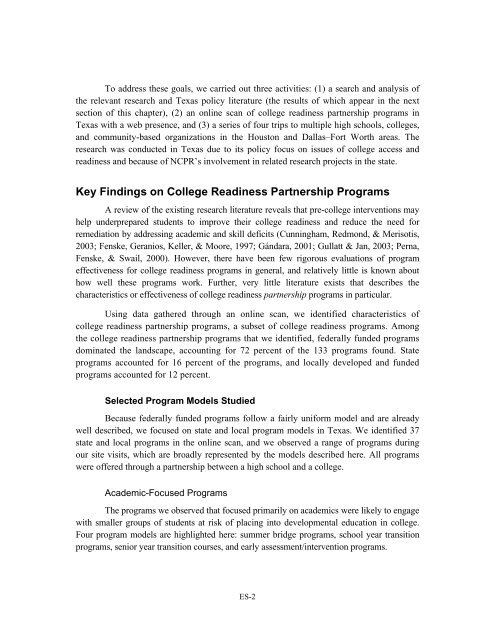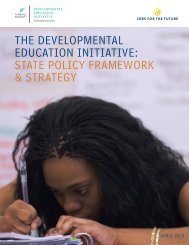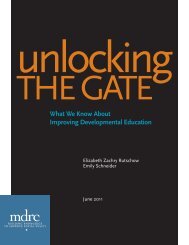Preparing High School Students for College - ERIC - U.S. ...
Preparing High School Students for College - ERIC - U.S. ...
Preparing High School Students for College - ERIC - U.S. ...
- No tags were found...
You also want an ePaper? Increase the reach of your titles
YUMPU automatically turns print PDFs into web optimized ePapers that Google loves.
To address these goals, we carried out three activities: (1) a search and analysis ofthe relevant research and Texas policy literature (the results of which appear in the nextsection of this chapter), (2) an online scan of college readiness partnership programs inTexas with a web presence, and (3) a series of four trips to multiple high schools, colleges,and community-based organizations in the Houston and Dallas–Fort Worth areas. Theresearch was conducted in Texas due to its policy focus on issues of college access andreadiness and because of NCPR’s involvement in related research projects in the state.Key Findings on <strong>College</strong> Readiness Partnership ProgramsA review of the existing research literature reveals that pre-college interventions mayhelp underprepared students to improve their college readiness and reduce the need <strong>for</strong>remediation by addressing academic and skill deficits (Cunningham, Redmond, & Merisotis,2003; Fenske, Geranios, Keller, & Moore, 1997; Gándara, 2001; Gullatt & Jan, 2003; Perna,Fenske, & Swail, 2000). However, there have been few rigorous evaluations of programeffectiveness <strong>for</strong> college readiness programs in general, and relatively little is known abouthow well these programs work. Further, very little literature exists that describes thecharacteristics or effectiveness of college readiness partnership programs in particular.Using data gathered through an online scan, we identified characteristics ofcollege readiness partnership programs, a subset of college readiness programs. Amongthe college readiness partnership programs that we identified, federally funded programsdominated the landscape, accounting <strong>for</strong> 72 percent of the 133 programs found. Stateprograms accounted <strong>for</strong> 16 percent of the programs, and locally developed and fundedprograms accounted <strong>for</strong> 12 percent.Selected Program Models StudiedBecause federally funded programs follow a fairly uni<strong>for</strong>m model and are alreadywell described, we focused on state and local program models in Texas. We identified 37state and local programs in the online scan, and we observed a range of programs duringour site visits, which are broadly represented by the models described here. All programswere offered through a partnership between a high school and a college.Academic-Focused ProgramsThe programs we observed that focused primarily on academics were likely to engagewith smaller groups of students at risk of placing into developmental education in college.Four program models are highlighted here: summer bridge programs, school year transitionprograms, senior year transition courses, and early assessment/intervention programs.ES-2





